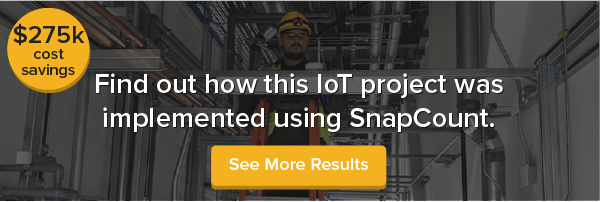
Most people have heard about the “internet of things” (IoT). It’s a term that refers to interconnected everyday objects – essentially, machines talking to each other. Fewer people have heard of the “internet of everything” (IoE), but I believe it’s a concept that’s far more relevant.
IoE casts a wider net by adding in people, processes, and data. It’s about exploring ways we can use the data and connectivity of IoT to improve our work, our lives, and our world.
At IoEnergy, what we do for our clients starts with energy efficiency, which typically means retrofitting the lights in a building and adding IoT controls to lower expenses and save energy. But our work doesn’t have to stop there. We now have the ability to introduce a whole new dimension of smart building analytics for our clients, which holds the potential to dramatically change the way our clients operate.
The industry tends to think about lighting projects in terms of a three-year payback. ROI typically comes in the form of energy and maintenance savings and utility rebates that help finance a retrofit project.
But in fact, the advantages and benefits of sophisticated IoT controls can surpass simple energy savings.
For example, imagine a company that occupies a multi-story building. How does the company know whether it’s optimally utilizing the entire office space? IoT sensors can provide the answer, by generating detailed data on occupancy and use patterns. Analyzing that data might reveal areas that are consistently underutilized. Armed with this insight, the company can now restructure the way it uses the office space. It’s even possible that by simply moving a few departments around, the company could eliminate an entire floor of unoccupied space – which could be sublet to someone else.
Suddenly, we’re not just talking about energy efficiency but about optimizing the use of an entire building. We’re also potentially uncovering new revenue sources, which can impact the company’s profit and loss statement in a much more profound way.
That’s the power of the internet of everything.
Selling IoT and the Triple Bottom Line
A decade ago, the business case for lighting projects was all about profit: return on investment and internal rate of return. Nowadays, though, a growing number of organizations recognize that lighting projects can influence the “triple bottom line”: profit, people, and the planet.
- Profit refers to every company’s basic need to generate positive operating income. Without profit, a company cannot exist for long. From the perspective of lighting and energy, retrofit projects should generate a profit for the company (or, at a minimum, not a loss).
- People refers to the occupant (user) experience. Can a lighting and energy retrofit project make the occupants of a building more comfortable, more productive, and safer?
- Planet refers to the broader footprint our lighting and energy usage creates in the world. Sustainability has become a core value for companies of all sizes, and carbon footprint reduction targets will increasingly be a key driver for retrofit projects in the coming years.
When I speak with clients and prospects, I often use profit as an entry point, but I love to switch the conversation over to people and the planet as quickly as I can. If the client already has initiatives in these areas, they welcome us as partners to help them in those initiatives.
For example, I had a great conversation recently with a healthcare system. I started by asking, “What are your sustainability goals? What are you doing as a system to respond to the climate crisis?” I soon learned they had been doing a lot with recycling and reducing their use of materials – all active, behavioral efforts.
"What are your sustainability goals? What are you doing as a system to respond to the climate crisis?"
This gave me a launching pad to talk about not only conducting an energy audit, but also passive sustainability improvements they could generate via a few key mechanical and digital upgrades. “By implementing these upgrades, you’ll be reducing greenhouse gases. You’ll be harvesting energy savings. And you don’t have to change the way you operate. Wouldn’t that be nice?”
IoT Executions That Contribute to the Triple Bottom Line
Many people are aware that sensors incorporated with lighting fixtures can detect and control lighting levels, which can produce significant energy savings. But sensors can also do much more.
For example, we’ve been working with a Silicon Valley technology manufacturer to install sensors in each lighting fixture in their facility. These sensors collect data about temperature, light level, occupancy, and Bluetooth usage. The data these sensors produce can be put to use in ways that go far beyond simple energy efficiency. For instance:
- The IoT software can integrate Bluetooth and RFID technology to create geofences around specific light fixtures. These geofence sensors can be used to track equipment, which can prevent valuable assets from being lost or stolen. The sensors can even track people, helping team members quickly locate each other.
- Occupancy information generated by the IoT sensors can be integrated with the building’s HVAC system, enabling the system to operate only in occupied areas – which reduces energy usage wasted on cooling empty conference rooms.
- The company can tag areas for a specific use (e.g., lunch area, engineering center, marketing department, etc.) and make decisions on the use of space based on real-time heatmaps.
These are just a few examples of how smart IoT controls can multiply the ROI of a lighting retrofit many times over. With an IoE approach, the lighting becomes a platform not merely for illumination, but for collecting rich streams of actionable data about the flow of people, energy, and resources throughout a building.
‘From the Top Down’
In a recent article on iotevolutionworld.com, Sanjiv Kaul, executive vice president of marketing at the IoT controls manufacturer Enlighted, stated, “If you want to know what's going on in a building, there's no better place to do that than to watch from the top down.”
In the same article, I talk about sensors being minicomputers where data is being collected 65 times per second. Think about the amount of information this provides!
This perfectly sums up the business case for including IoT in lighting projects. The internet of things, and the overarching internet of everything, gives us the opportunity to transform humble lighting fixtures into a powerful source of insights and intelligence that can improve not only the way companies operate, but the way we occupy our world.
And yet, even drilling this lofty ambition back down to straightforward ROI, the benefits of IoT are still clear. After all, a considerable portion of the assets of many companies is real estate. If these companies want to achieve their financial goals (let alone their sustainability goals), they need to understand how to wring the most value possible out of every square foot of that real estate. Creating this value starts with data.
We’re excited to be part of it.






Share this post: